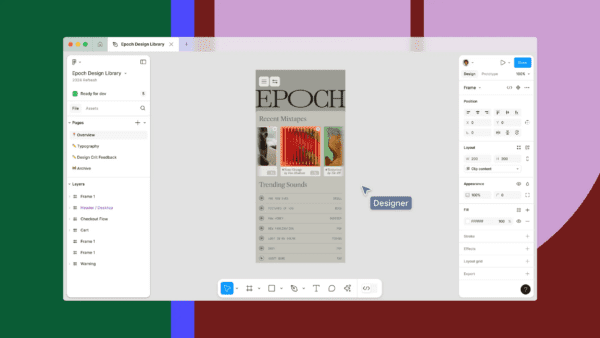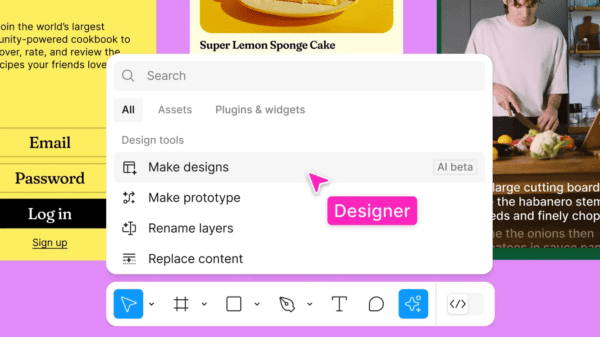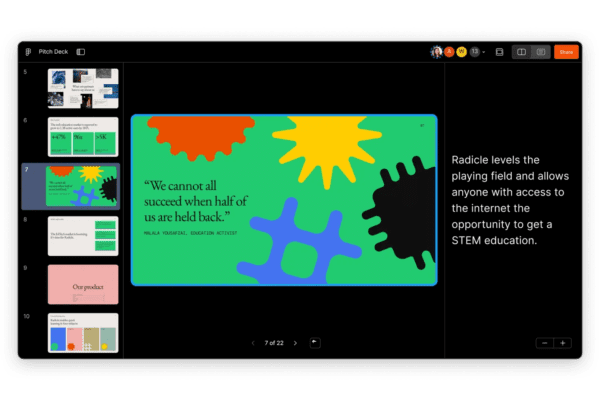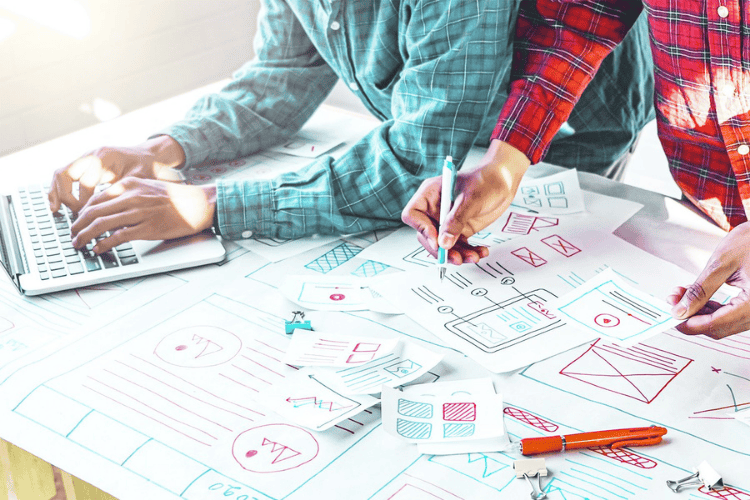Note: Looking for this year’s updated Config highlights and updates?
See our list of Figma Config Recap for 2025.
Written By: Janine Loo
Can you believe we’re already halfway through 2024?! The UX design industry continues to evolve at an incredible pace with each passing year, and staying ahead requires keen attention to the tools and conferences shaping our industry.
Today’s blog post dives deep into the latest from Config 2024 – Figma’s annual UX conference that gathered designers, developers, and creative professionals in San Francisco, California, from June 26-27. If you weren’t able to attend IRL, you can visit Figma’s YouTube channel to check out 90+ videos including the event’s keynote from Dylan Field, Figma’s CEO and Co-founder, and talks from some of the brightest minds in UX and beyond.
Figma has cemented its place as the industry standard for UX design, known for its seamless features and collaborative abilities to empower UX teams to create together, no matter where they are in the world. Whether you’re a seasoned UX designer or just starting, Figma’s value lies in its ability to streamline workflows and enhance design precision, making it indispensable for professionals aiming to deliver top-notch user experiences efficiently.
At Config 2024, Figma unveiled its latest feature releases, and WOW, are we excited! From enhanced collaboration tools and refined interface capabilities to AI advancements and the new “Figma Slides” tool, these updates promise to elevate designers’ productivity and creativity.
Let’s unpack these new releases and features from Config 2024, and chat about how these updates will optimize your designs and processes!
Figma’s Newest UI (User Interface) Design
Image source: https://www.figma.com/blog/config-2024-recap/
Starting off, we have the redesign of Figma’s Interface, or what they call ‘UI3,’ and it’s a breath of fresh air! The interface still retains the familiar Figma structure (don’t worry!) — we still have layers, pages, and properties, but it looks a bit different and features greater functionality.
The toolbar has moved to the bottom and now includes resizable, collapsible panels, and there is noticeably less clutter within the different UI panels. For example, when a user requests a spotlight on a specific element, the surrounding UI discreetly fades, ensuring minimal distraction. Plus, the toolbar’s new location also helps declutter the space, giving you a larger canvas for design. This redesign also allows for much more personalization and power over your panels. You’ll be able to customize the size of your panels and have them appear when and where you want them!
Figma is employing a measured rollout for this new interface design, so there will be a migration period with a toggle option to switch between old and new UIs. As designers, we know how impactful and disorienting physical design changes can be, which is why this rollout strategy is great! If you’re not totally comfortable with all the changes to the UI, no worries — you can move at your own pace!
So, what does this mean for designers? It means spending much more time focused on designing and less time distracted by the interface.
How this Update will Optimize your Workflow:
- Decluttered Workspace: The new design prioritizes simplicity, making your design canvas your central focus. This can help us zero in on what we are designing and enter that ‘flow state’ of utmost creativity and productivity. The Figma interface takes a step back, and your design canvas takes the spotlight.
AI Updates Coming to Figma in 2024
The next update, and certainly one of the most talked about updates, is the integration of AI functionalities into the Figma platform. Artificial intelligence as we know it is changing the way we work, think, and create, and now, it’s changing the design process too! As intimidating as it sounds, AI has the potential to significantly streamline your work process and allow you to allocate your time more efficiently.
Let’s take a deeper look at some of the new AI functionalities:
- “Suggest Auto Layout” — Through analyzing the selected elements, Figma’s AI can intelligently suggest your project’s most likely auto layout setup. These setup suggestions are exciting, to say the least, and will likely save designers loads of time. Long gone are the days of manually configuring constraints!
- “Search for Similar” — With this search feature, designers can scan across the entire Figma community and access a wealth of inspiration and ready-made components. Similar to the other AI updates in Figma, this feature accelerates your workflow and makes it easier to access inspiration, learn from others, and keep you creative.
- “Name Layers” — This feature eliminates the tedious task of labelling your layer names. Although this may seem like a small change, it helps keep everything on your end nice and organized.
- “Make Design” — The “make design” feature is arguably the most discussed and debated AI update from the Config 2024 conference. This function transforms a text prompt within seconds and generates an entire app UI. While still in its early stages, this capability offers a compelling solution to our dreaded “blank canvas” and “designer’s block” problems. This feature provides a great starting point for those struggling to find inspiration.
Image source: https://www.figma.com/blog/config-2024-recap/
When Figma announced these AI features, we noticed many users took to social media to share that they felt fearful and slightly intimidated. Let’s be honest, we know AI is a slightly divisive and hot-button topic right now. These continuous AI advancements can feel overwhelming, provoking feelings of uncertainty and skepticism, but it’s important to remember that AI, when used properly, can also be very exciting! Our team believes that AI should be seen as our friend – a tool in your designer toolbox that supercharges efficiency, productivity, and offloads some of those less enjoyable tasks.
AI’s role in design should be to empower designers, not replace them! After all, you’ll never truly replace the power of the human touch. For example, Figma’s new “Make Design” feature is great, but it will only provide you with the most straightforward answer to your prompt or problem. The creation process still requires a designer who deeply understands human experiences and is connected to finding a solution to tricky, unique, and nuanced design problems. AI is an imitator, not an innovator!
How these New Updates WIll Optimize your Workflow:
- Reduced Administrative Tasks: All of Figma’s new AI features allow you to focus on your projects, designs, and brainstorming processes, and not feel bogged down by all the little things (like naming layers)!
- Clean and Organized Workflows: The “Suggest Auto Layout” and “Name Layers” updates will radically declutter and organize your designs, allowing you to maintain a sharp focus on them.
Here are two ways to join Figma’s AI beta waitlist:
- Log in to Figma.
- Go to the modal titled: ‘Everything we launched at Config 2024’.
- Under ‘Meet Figma AI,’ click ‘Learn more’.
- Click ‘Join Waitlist’.
Or
- Log in to Figma.
- Click on the question mark icon in the bottom right corner.
- Click ‘Join Waitlist’.
Figma Slides: The Newest All-In-One Tool From Config 2024
We saved the best for last: Figma Slides! This brand-new update is not just another slideshow tool – it’s a product that leverages Figma’s core strengths of collaboration and iteration to transform presentations into dynamic, engaging experiences. With Figma Slides, we can say goodbye to one-way lectures and say hello to intelligent, adaptive and collaborative demonstrations.
Our prediction is that Figma Slides will cause big waves in the design and UX world and beyond. We can also see this feature being used by anyone for any presentation purpose – move over PowerPoint and Google Slides!
Image source: https://www.figma.com/blog/figma-slides/
The Features of Figma Slides:
- Embedded Prototypes — One of the standout features of Figma Slides is its ability to paste your prototypes right into your slide deck. This allows for a much cleaner and seamless way to share your work with your team and stakeholders, and eliminates the messiness of using external links or creating walk-through videos.
- Responsive Views — Figma Slides will look beautiful on all devices and screens, ensuring your presentation is useful for anyone accessing it from anywhere.
- Templates — You can now build presentations from customizable templates and save these templates for later use. Your custom slide deck templates can ensure your style and brand are consistent across presentations, and you can even add in your brand’s colour palette, typography, and logos. You can also ensure the rest of your team is on the same page by sharing your custom template with others in your organization!
- Interactive Elements — With Figma Slides, presenters can create presentations with interactive elements to keep audiences engaged and part of the conversation. Polls, alignment scales, voting capabilities, and what they call ‘face piles’ allow you to gauge whether your audience is on the same page as you, what they like, what they agree with, and more. These elements can help capture feedback and streamline decision-making conversations.
Image Source: https://help.figma.com/hc/en-us/articles/24246820870807-Add-live-interactions-to-slides
How These New Updates Will Optimize Your Workflow:
- An ‘All in One’ Tool: With Figma Slides built right into the Figma ecosystem, designers can pull in elements and prototypes from existing or past projects, making it easy to ‘do it all’ in Figma. Not only do we think Figma Slides will up your presentation game, but it’ll also save you tons of time!
Figma Slides is currently in free beta but will be available on free and paid plans in early 2025. Learn more here.
The Future of the UX Design Industry
Figma’s Config 2024 updates offer a clear vision of the design industry’s future. The enhancements in UI simplification, developer tools, AI integration, and the introduction of Figma Slides all paint a picture of a more collaborative, efficient, and innovative future.
As AI continues to establish itself in the UX design world, we are gaining a clearer idea of all the ways it can empower us in our workflows. When used correctly, AI can allow designers to focus on more strategic and creative aspects of their work. Moving forward, we can expect to see AI integrated nearly everywhere, and in ways that empower, not overpower us.
The future also looks very bright for us remote and hybrid folks. With the launch of Figma Slides, we can see there is a growing focus on interactive presentations with real-time collaboration tools. Applications like Figma Slides will make it even easier for remote teams to stay aligned and engaged.
The design industry is forever changing and growing in new ways, and with tools like Figma leading the way, we can expect a landscape where collaboration is effortless, AI enhances productivity, and remote work is fully supported. We hope that the updates that emerged from Config 2024 have you as excited as we are about the future of design tools!










